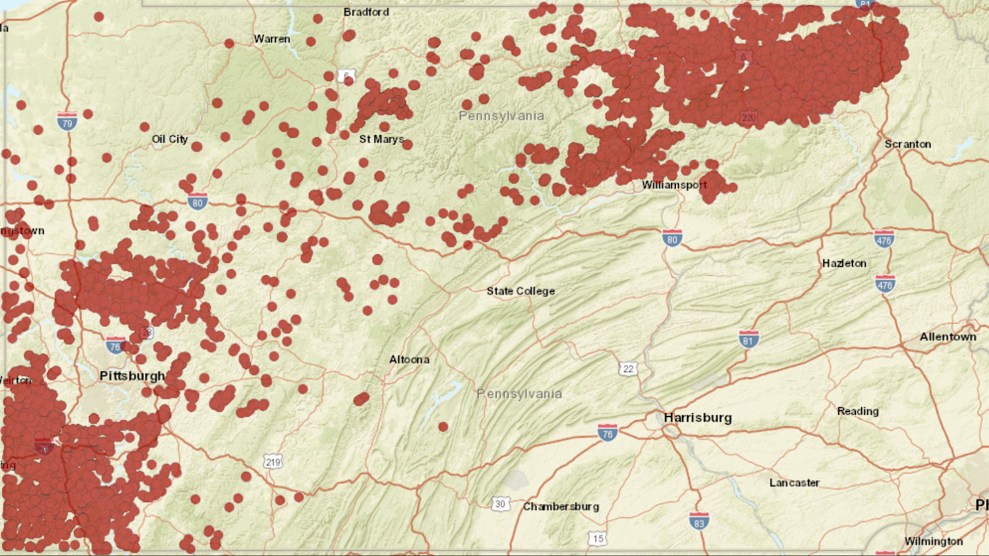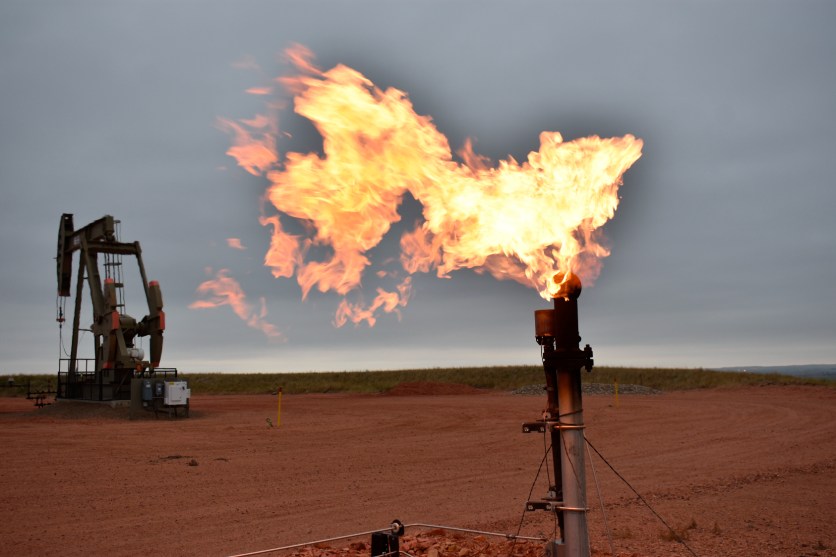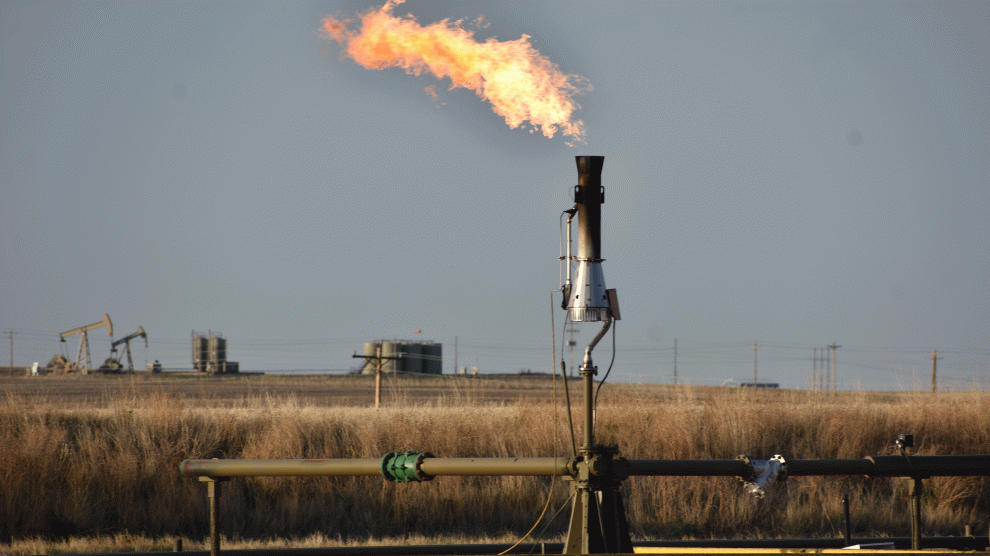
Methane is flared at at a North Dakota oil well pad in May 2021.Matthew Brown/AP
This story was originally published by the Guardian and is reproduced here as part of the Climate Desk collaboration.
More than 1,000 “super-emitter” sites gushed the potent greenhouse gas methane into the global atmosphere in 2022, the Guardian can reveal, mostly from oil and gas facilities. The worst single leak spewed the pollution at a rate equivalent to 67 million running cars.
Separate data also reveals 55 “methane bombs” around the world—fossil fuel extraction sites where gas leaks alone from future production would release levels of methane equivalent to 30 years of all US greenhouse gas emissions.
Methane emissions cause 25 percent of global heating today and there has been a “scary” surge since 2007, according to scientists. This acceleration may be the biggest threat to keeping below 1.5C of global heating and seriously risks triggering catastrophic climate tipping points, researchers say.
The two new datasets identify the sites most critical to preventing methane-driven disaster, as tackling leaks from fossil fuel sites is the fastest and cheapest way to slash methane emissions. Some leaks are deliberate, venting the unwanted gas released from underground while drilling for oil into the air, and some are accidental, from badly maintained or poorly regulated equipment.
Fast action would dramatically slow global heating as methane is short-lived in the atmosphere. An emissions cut of 45 percent by 2030, which the UN says is possible, would prevent 0.3C of temperature rise. Methane emissions therefore present both a grave threat to humanity, but also a golden opportunity to decisively act on the climate crisis.
“The current rise in methane looks very scary indeed,” said Prof Euan Nisbet, at Royal Holloway, University of London in the UK. “Methane acceleration is perhaps the largest factor challenging our Paris agreement goals. So removing the super-emitters is a no-brainer to slow the rise—you get a lot of bang for your buck.”
“Methane emissions are still far too high, especially as methane cuts are among the cheapest options to limit near-term global warming,” said Fatih Birol, head of the International Energy Agency. “There is just no excuse.”
The methane super-emitter sites were detected by analysis of satellite data, with the US, Russia and Turkmenistan responsible for the largest number from fossil fuel facilities. The biggest event was a leak of 427 metric tons an hour in August, near Turkmenistan’s Caspian coast and a major pipeline. That single leak was equivalent to the rate of emissions from 67 million cars, or the hourly national emissions of France.
Future methane emissions from fossil fuel sites—the methane bombs—are also forecast to be huge, threatening the entire global “carbon budget” limit required to keep heating below 1.5C. More than half of these fields are already in production, including the three biggest methane bombs, which are all in North America.
“Methane’s short lifetime means reduction of its emissions is one of the few options we still have to stay below 1.5C,” said Dr Lena Höglund-Isaksson, at the International Institute for Applied Systems Analysis in Austria. “If you exceed that level, even temporarily, you might trigger irreversible effects.” The climate is already on the brink of multiple tipping points that could drive runaway climate change, scientists warned recently.
“Methane is the worst thing in the struggle to hold back the [climate] domino pieces, because it’s pushing them over very quickly,” said Kjell Kühne at the Leave it in the Ground Initiative. “Having so many methane bombs out there is really worrisome.”
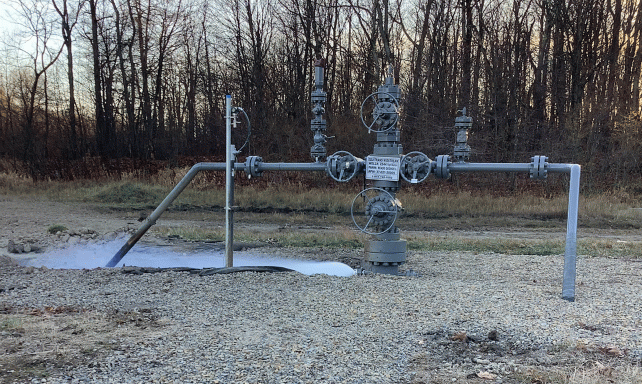
Methane, invisible in smaller quantities, is seen leaking last November from an Equitrans Midstream gas storage well near Jackson Township, Pennsylvania. Over two weeks, the well spewed massive amounts of methane into the atmosphere.
Pennsylvania Department of Environmental Protection via AP
As a greenhouse gas, methane is a double-edged sword: it traps 80 times more heat than carbon dioxide, but it fades from the atmosphere in about a decade, far faster than the century or more taken by CO2.
In 2021, the last year for which full data is available, methane reached 1,908 parts per billion, 2.6 times higher than before human activity started transforming the atmosphere. Its role in global heating is often overlooked, but human-caused methane emissions are responsible for about a third of the rise in global temperatures seen over the last century. Today, the impact remains large, with the methane in the atmosphere responsible for about 25 percent of the heat trapped by all greenhouse gases.
Recent rises in annual methane emissions are accelerating. “The highest growth rates we’ve ever seen have been just in the last few years, since 2020,” said Nisbet.
About 40 percent of human-caused methane emissions come from leaks from fossil fuel exploration, production and transportation. These rose by almost 50 percent between 2000 and 2019. Another 40 percent comes from agriculture, dominated by burping cattle, and 20 percent from rotting waste sites. All are forecast to rise.
The recent surge in methane is largely being driven by increased activity by microbes that decompose organic matter, such as those in wetlands and the stomachs of livestock. It looks like rising global temperatures enable microbes to produce more methane, which then causes more global heating, creating a vicious circle. “It’s very much like a feedback effect and it’s scary in lots of ways,” said Nisbet. “We really have to get methane under control.”
For fossil fuel leaks at least, that goal is within reach. At 80 percent of oil and gas sites and 98 percent of coalmines, the measures to plug leaks and end deliberate venting would pay for themselves, by selling the extra gas captured, or could be implemented at low net cost, according to the UN.
Satellite data analyzed by the company Kayrros has identified 1,005 super-emitter events in 2022, of which 559 were from oil and gas fields, 105 from coalmines, and 340 from waste sites, such as landfills. The events can last between a few hours and several months. “Before the satellite technology, we didn’t have a clue where these big events were happening but now, the good thing is at least we have some monitoring,” said Höglund-Isaksson.
Turkmenistan had the highest number of super-emitting events—184. “They vent like crazy,” said Christian Lelong at Kayrros.
Little is known about fossil fuel production under Turkmenistan’s repressive dictatorship. But the colossal leaks may be the result of ageing Soviet-era equipment, experts said, or attempts to avoid scrutiny over flaring, when vented gas is ignited to form less damaging CO2 but produces easily visible flames. Turkmenistan dominated the top 100 largest super-emitter events from fossil fuels, with 70 events.
The US had 154 super-emitter events from fossil fuel sites. The biggest was in March last year, near San Antonio in Texas, releasing 147 metric tons an hour, while the second biggest was in a fracking field in rural Pennsylvania, and lasted for 13 days.
Russia had 120 super-emitting events in 2022. Other nations in the top 15 include Algeria, China, Saudi Arabia, Australia, Iran and Iraq. The second largest fossil fuel leak of the year—356 metric tons an hour—was in Iraq, apparently from an oil refinery near Basra. Most of Australia’s super-emitting leaks were from coalmines in the Bowen Basin in Queensland.
Overall, the Kayrros data shows no decline of super-emitter events between 2021 and 2022, nor any decline in the company’s wider datasets going back to 2019. “The annual rate of change is very close to zero,” said Lelong.
Super-emitter events from other human sources were also evident in the satellite data, including large waste dumps, illegal tapping of gas pipes, and rice paddies, in countries including India, Pakistan, Bangladesh and Argentina.
There will be even more super-emitter events not detected by current satellites. Water interferes with the infrared signals used to detect the methane, meaning leaks from offshore facilities, in very humid regions, or when there are clouds or snow, are much harder to spot. But forthcoming satellites are expected to have sharper eyes.
In May 2022, the Guardian revealed that the world’s biggest fossil fuel firms were quietly planning scores of “carbon bomb” oil and gas projects that would drive the planet to climate catastrophe.
Now, new research from the same scientists has identified 55 “methane bombs”: gas fields where leakage alone from the full exploitation of the resources would result in emissions equivalent to at least a billion metric tons of CO2.
Gas fields also produce methane, which is sold to customers and burned, pumping carbon dioxide into the atmosphere. When these emissions are combined with the leaked methane, the list of bombs that would result in global heating equivalent to 1 billion metric tons of CO2 swells to 112.
In the scientists’ central estimate, the total emissions from these 112 methane bombs would be equivalent to 463 billion metric tons of CO2—more than a decade of current global emissions from all fossil fuels. The methane bomb emissions are also significantly higher than the emissions limit of 380 billion metric tons of CO2 from all sources needed to keep global heating below 1.5C, according to the Global Carbon Budget’s recent estimate.
“I’m amazed how long this list is, and how many of these giant projects are still being pushed forward,” said Kühne, who did the analysis. He warned: “The impacts of methane are front-loaded—they happen very soon after its emission. Last year’s gas leaks are killing people this year,” via the climate impacts they cause.
“At the same time, methane is a huge opportunity to reduce global heating,” Kühne said. “That is the unrealized potential in defusing methane bombs, to stop runaway climate change. I think it might be the last opportunity, because we’re already seeing some of these tipping elements tip over. We’re in a climate emergency and [stopping fossil fuel methane leaks] is top of the list.”
The heavily fracked Marcellus Shale, centered on Pennsylvania and West Virginia, in the US is the biggest methane bomb. Its estimated future emissions from methane leakage alone are equivalent to 17 billion metric tons of CO2, more than three times the total annual emissions of the US.
The Haynesville/Bossier Shale, in Texas and Louisiana, is the second biggest methane bomb, with estimated emissions from leakage equivalent to 9.7 billion metric tons of CO2 emissions. The Montney Play in western Canada is another fracking field and the third-biggest methane bomb. In the rest of the top 10, three methane bombs are in Russia, two more in the US, and one each in Turkmenistan and Qatar.
The scientists also made a conservative estimate of the impact of the 112 methane bombs, but these emissions still represent more that 80 percent of the remaining global carbon budget for 1.5C of global heating. A worst-case estimate indicated emissions equivalent to 729 Gt CO2 from the methane bombs, almost double the planet’s remaining 1.5C carbon budget.
The US is among the worst in number of “methane bombs”
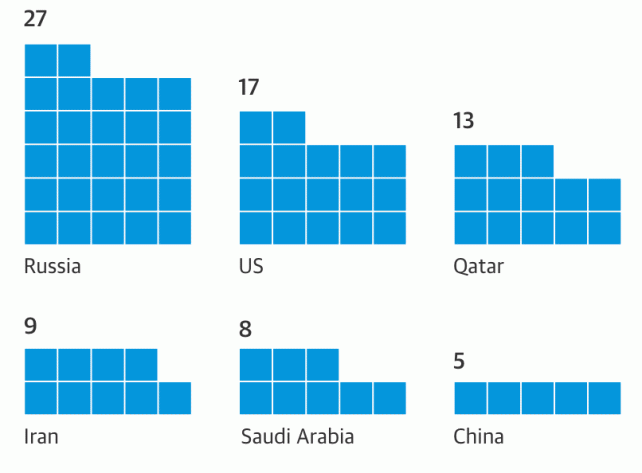
Number of projects expected to produce more than 1 billion metric tons of CO2 equivalent from methane leaks and burning of produced gas.
Guardian graphic; Kjell Kühne, Lingo
The looming methane-driven climate catastrophe is clear, but the growing role of the satellite detectives and rising political momentum for action on the potent gas give reason for cautious hope.
A global methane pledge, to cut human-caused emissions by 30 percent by 2030, was announced at the UN’s Cop26 climate summit in Glasgow in 2021. The number of nations backing the pledge has now reached 150, although some key countries have not signed up, including Russia, China, Turkmenistan, Iran and India.
The 30 percent cut would avoid 0.2C of global heating by around 2050, and the subsequent reduction in air pollution would also prevent about 6 million premature deaths and 580 million metric tons of crop losses. “It’s a great step forward, seeing so many countries start moving in that direction,” said Kühne. “But it’s a pledge—we want to see it implemented.”
Lelong, from Kayrros, is optimistic: “Now that we have the technology and the [global methane pledge] in place, our expectation is that the map [of fossil fuel supermitters] should be completely dark in three years’ time.”
“That’s an achievable target,” he said. “We now know where these big sources are coming from, we know they’re avoidable, so there’s really no reason not to address them.”
Kayrros has signed a deal to provide leak data to the UN Environment Programme’s new methane alert and response project. UNEP is expected to use the near-real-time satellite data to identify super-emitting polluters and press them to stem the leaks. Then, after about three months, the information would be published, with the first public data expected in the second half of 2023.
The scrutiny is necessary: the International Energy Agency said last year that methane emissions from the fossil fuel sector were about 70 percent greater than those actually declared by governments. The IEA estimates that, to have an even chance of keeping below 1.5C of global heating, these methane leaks must fall by 75 percent by 2030.
A 50 percent methane cut from fossil fuel sites could be achieved essentially for free, according to a study. The sale of the captured gas would offset the cost of plugging the leaks, which often simply involves replacing defective parts. Billions of dollars of gas is either leaked or deliberately wasted each year, and high gas prices due to Russia’s war in Ukraine has made the economic case even stronger.
In contrast, cutting methane from other human sources is significantly harder. Options that incur no net cost represent just 16 percent of emissions from waste sites and 30 percent of those from cattle. Draining wetlands is unthinkable for most scientists, as that could produce large CO2 emissions and destroy precious habitat for wildlife.
“Oil and gas is really the easiest and cheapest way,” said Höglund-Isaksson. However, she said: “The profit margins in that sector are so high from simply increasing gas production, but the profit margins from reducing methane emissions are relatively small. You need regulations that force them to do it.”
The three biggest “methane bombs” are in North America
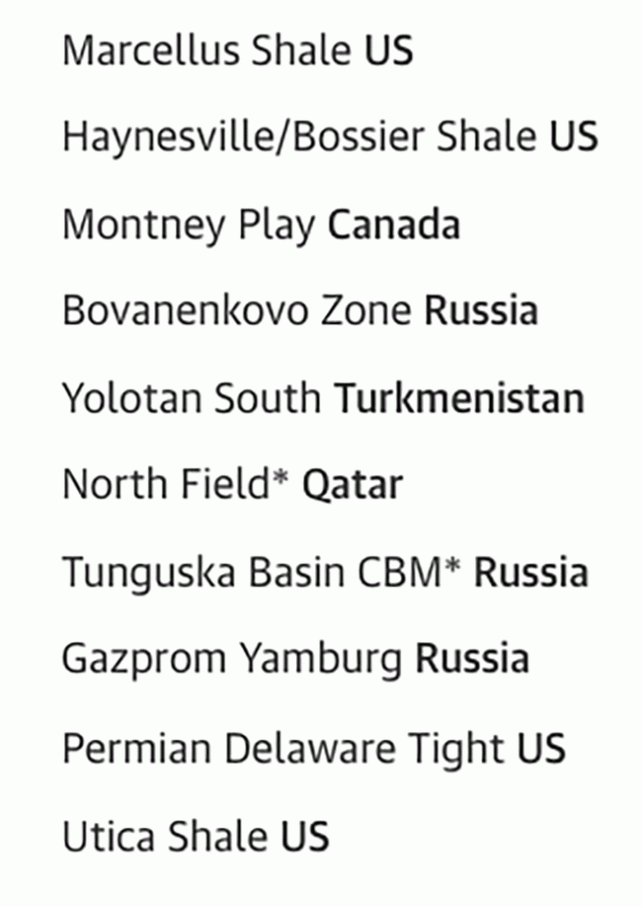
*Not yet in production. Order is based on full exploitation of the field in question. All are gas/oil fields except Tunguska Basin coal-bed methane field.
Guardian graphic; Kjell Kühne, Lingo
Regulations are coming. In the US, for example, companies will be charged $900 per metric ton for leaks of methane from 2024, rising to $1,500 in 2026. The big leak in Pennsylvania would have incurred a cost of $220,000 an hour at the higher rate. The European Union has proposed regulations requiring companies to plug leaks and to ban routine venting and flaring, and Nigeria recently announced new methane regulations.
A spokesperson for the International Association of Oil and Gas Producers said: “Since 2015, average oil production has increased by about 0.5 percent a year through to 2021 to meet global energy demand. Despite this increase, methane emissions [from the fossil fuel sector] have remained stable, while quantification and estimation techniques have advanced rapidly. The global oil and gas industry is focused on building on that improved measurement to deliver significant reductions in the coming years.”
Jonathan Banks, global director for methane pollution prevention at the NGO Clean Air Task Force, said: “There’s no solution to climate change without addressing methane emissions. Fast action will have an immediate impact on warming, helping to finally bend the curve on climate change.”
“I’m very happy that, finally, methane is actually on the policy agenda, because this has not been the case—it’s been drowned out by the CO2 issue,” said Höglund-Isaksson. “But we are also clearly running out of time, and I would really like to see much, much more happening, because there’s so much that could be done, particularly on oil and gas.”
The “methane bomb” analysis is based on 2020 information on gas-rich fields from industry data provider Rystad Energy and builds on research published in the journal Energy Policy by Kühne and colleagues. This was combined with data on methane leak rates from fossil fuel operations and the heating impact of methane. The central estimates for the methane bombs used a leak rate of 2.3 percent, based on a US study, and the heating impact over 20 years, which is 82.5 times that of CO2. The conservative estimate used a leak rate of 1.7 percent from the International Energy Agency, and the heating impact over 100 years, which is 30 times that of CO2. The worst-case estimate used a leak rate of 3.7 percent, based on analysis of the Permian basin in the US, and the immediate heating impact of methane, which is 120 times that of CO2. The full list of methane bombs and more information on the methodology is here.
